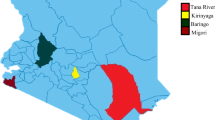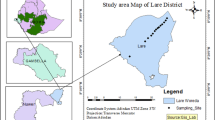Abstract
In the central western Senegal, great progress has been made against malaria following the successful implementation of effective malaria control interventions, including Indoor Residual Spraying (IRS) and Seasonal Malaria Chemoprevention (SMC). However, residual transmissions are still occurring in several hotspots involving some secondary vector species, such as An. melas. This study was undertaken in central and western costal area of Senegal, to provide the first data on the insecticide susceptibility of local An. melas population using WHO test kits, the allelic frequencies of the Kdr and Ace-1R mutations using qPCR and also re-evaluate the palp biometry technique as a proxy to discriminate An. melas from other freshwater species within the Gambiae complex. Insecticide susceptibility test revealed a susceptibility of An. melas to Pirimiphos-methyl, and Bendiocarb, the two main non-pyrethroid insecticides recommended by the WHOPES for use in public health. The molecular characterization of the Kdr and Ace-1 target site mutations revealed the absence of both mutations. The biometric palps technique has been a valid method for species diagnose between An. melas and its freshwater sibling. Indeed, while the former species collected exclusively from salty breeding sites (with a level of salinity above 21 g/l), consistently displayed a palpal index ≥0.81; the latter, sampled for breeding site of low salinity level (up to 3.6 g/l) and subsequently mainly identified as An. arabiensis and in a lesser extend as An. gambiae, presented a palpal index less than 0.81. This study has re-evaluated and validated the palps biometric technique as a morphological tool for the identification of An. melas, which population still susceptible to main insecticide used in public health and revealed the absence of KDR and Ace-1 mutations. The data provided here can help the Senegalese NMCP to better target and efficiently control An. melas populations in malaria hotspot, where they contribute to maintain residual transmission hampering the malaria elimination goal.


Similar content being viewed by others
Abbreviations
- IRS:
-
Indoor Residual Spraying
- SMC:
-
Seasonal Malaria Chemoprevention
- WHO:
-
World health organization
- Kdr:
-
Knock-down resistance
- Ace-1:
-
Acetylcholinesterase (Ace-1) target site mutation
- WHOPES:
-
World Health Organization Pesticide Evaluation Scheme
- NMCP:
-
National Malaria Control program
- PCR:
-
Polymerase chain reaction
- PVA:
-
Polyvinyl Alcohol
- DNA:
-
desoxyribonucleic Acid
- DDT:
-
Dichlorodiphényltrichloroéthane
References
Akogbéto M (1995) Etude entomologique sur la transmission du paludisme côtier lagunaire : cas d’un village construit sur un lac d’eau saumâtre. Ann Soc belge Méd trop 75:219–227
Akogbéto M, Yakoubou S (1999) Resistance of malaria vectors to pyrethroids used for impregnated bednets, Benin, West Africa. In Bull Soc Path Exo 92:123–130
Attolou R., Badirou K., Youssouf R.A., Gnanguenon V., Govoetchan R., Ahogni I., Anagonou R., Akinrou B., Ossè R. and Akogbéto M. (2016). Seasonal and temporal distribution of Anopheles melas in Djegbadji, a coastal Lagoon Village of southwestern Benin. Vect Biol J
Bass C, Nikou D, Donnelly MJ, Williamson MS, Ranson H, Ball A et al (2007) Detection of knockdown resistance (kdr) mutations in Anopheles gambiae: a comparison of two new high-throughput assays with existing methods. Malar J 6:111
Bass C, Nikou D, Vontas J, Williamson MS, Field LM (2010) Development of high-throughput real-time PCR assays for the identification of insensitive acetylcholinesterase (ace-1R) in Anopheles gambiae. Pestic Biochem Physiol 96:80–85
Caputo B, Nwakanma D, Jawara M, Adiamoh M, Dia I, Konate L, Petrarca V, Conway DJ (2008) Della Torre a. Anopheles gambiae complex along the Gambia river, with particular reference to the molecular forms of an. Gambiae s.s. Malar J 7:182
Chauvet G, Davidson G, Coz J (1969) Le complexe Anopheles gambiae en Afrique continentale et à Madagascar. Cahiers ORSTOM, série Entomologie médicale et Parasitologie, 7(1): 9–12
Coluzzi M (1964) Morphological divergences in the Anopheles gambiae complex. Riv Malar 43:197–232
Coluzzi M (1965) Biological observations on the Anopheles gambiae complex. Cahiers ORSTOM, série Entomologie médicale et Parasitologie, 3/4:183–184
Coluzzi M, Petrarca V, Di Deco MA (1985) Chromosomal Inversion intergradation and incipient speciation in Anopheles gambiae. Boll Zool 52:45–63
Dia AK, Guèye OK, Niang EA, Diédhiou SM, Sy MD, Konaté A, Samb B, Diop A, Konaté L, Faye O (2018) Insecticide resistance in Anopheles arabiensis populations from Dakar and its suburbs: role of target site and metabolic resistance mechanisms. Malar J 17(1):116. https://doi.org/10.1186/s12936-018-2269-6
Diabate A, Baldet T, Chandre F, Akoobeto M, Guiguemde TR, Darriet F, Brengues C (2002) The role of agricultural use of insecticide in resistance to pyrethroids in Anopheles gambiae s.l. in Burkina Faso. Am J Tropic Med Hygiene 67:617–622
Diagne N, Fontenille D, Konate L, Faye O, Legros F, Lamizana MT et al (1994) Les anophèles du Sénégal. Bull Soc Pathol Exot 87:267–277
Diop A, Diop A, Konaté L, Fontenille D, Gaye O, Diouf M, Diagne M, Faye O (2002) Rôle d’Anopheles melas Theobald dans la transmission du paludisme dans la mangrove du Saloum (Sénégal). Parasite 9:239–246
Faye O (1987) Contribution à l'étude des Anophelinae (Diptera-Culicidae) et de la transmission du paludisme dans la zone de barrage anti-sel de Bignona (Ziguinchor, Sénégal). Thèse de Doctorat de 3ème Cycle, Université C.A.D. (Faculté des Sciences & Techniques), Dakar, 202 p
Faye O, Gaye O, Faye O, Diallo S (1994) La transmission du paludisme dans les villages éloignés ou situés en bordure de la mangrove du Sénégal. Bull de la Société de Pathologie Exotique 87:157–163
Gillies M.T., De Meillon (1968) The Anophelinae of Africa south of the Sahara. South Afr Inst Med Res 343
Gnanguenon V (2015) Variabilité de la transmission du paludisme, de la durabilité et de l’efficacité des moustiquaires imprégnées d’insecticide en fonction des faciès éco-géographiques en zone de savane et de forêt dégradée au Bénin, Afrique de l’Ouest. Université d’Abomey-Calavi, République du Bénin 238p
Lemasson J, Fontenille D, Lochouarn L, Dia I, Simarda F (1997) Comparison of behaviours and vector efficiency of Anopheles gambiae and Anopheles arabiensis 122 (Diptera, Culicidae) in Barkedji, a sahelian area of Senegal. J Med Entomol 34:396–403
Musapa M., Kumwenda T., Mkulama M., Chishimba S., Norris D.E., Thuma P.E., Mharakurwa S. (2013) A simple Chelex protocol for DNA extraction from Anopheles spp. J Visual Exp
Niang EHA, Konaté L, Diallo M, Faye O, Dia I (2016) Patterns of insecticide resistance and knock down resistance (kdr) in malaria vectors An. arabiensis, An. coluzzii and An. gambiae from sympatric areas in Senegal. Parasit Vectors 9(1):71. https://doi.org/10.1186/s13071-016-1354-3
Odetoyinbo JA (1969) Preliminary investigation on the use of a light-trap for sampling malaria vectors in the Gambia. Bull Org Mond Sante Bull Wld Hlth Org 40:547–560
OMS (2017a) Procédures pour tester la résistance aux insecticides chez les moustiques vecteurs du paludisme
OMS (2017b) Procédures pour tester la résistance aux insecticides chez les moustiques vecteurs du paludisme – seconde édition
Pages F, Texier G, Pradines B, Gadiaga L, Machault V, Jarjaval F, Penhoat K, Berger F, Trape F, Rogier C, Sokhna C (2008) Malaria transmission in Dakar : a two-year survey. Malar J 11:1–11
Palsson K, Pinto J, do Rosario VE, Jaenson TG (1998): The palpal ratio method compared with PCR to distinguish between Anopheles gambiae s.s. and A. melas from Guinea Bissau, West Africa. Acta Trop, 70(1), 101–107
PNLP (2018) Bulletin épidémiologique annuel 2017 du paludisme au Sénégal
Reddy MR, Overgaard HJ, Abaga S, Reddy VP, Caccone A, Kiszewski AE, Slotman MA (2011) Outdoor host-seeking behavior of Anopheles gambiae mosquitoes following initiation of malaria vector control on Bioko Island, Equatorial Guinea. Malar J 10:184
Robert V, Awono-ambene HP, Thioulouse J, Med Entomol J (1998) Ecology of larval mosquitoes, with special reference to Anopheles arabiensis (Diptera: Culcidae) in Market-Garden Wells in Urban Dakar, Senegal. Retrieved from https://academic.oup.com/jme/article-abstract/35/6/948/2221744
Scott JA, Brogdon WG, Collins FH (1993) Identification of single specimens of the Anopheles gambiae complex by the polymerase chain reaction. Am J Trop Med Hyg 49(4):520–529
Sy O, Konaté L, Ndiaye A, Dia I, Diallo A, Taïrou F, Bâ EL, Gomis JF, Ndiaye JL, Cissé B, Gaye O, Faye O (2016) Identification des gîtes larvaires d’anophèles dans les foyers résiduels de faible transmission du paludisme « hotspots » au centre-ouest du Sénégal. Bull Soc Pathol Exot 109:31–38
Sy O, Niang EHA, Ndiaye M, Konaté L, Diallo A, Ba ECC, Tairou F, Diouf E, Cissé B, Gaye O, Faye O (2018) Entomological impact of indoor residual spraying with pirimiphos-methyl: a pilot study in an area of low malaria transmission in Senegal. Malar J 17(1):64
Sy O, Niang EHA, Diallo A (2019) et al. Evaluation of the effectiveness of a targeted community-based IRS approach for malaria elimination in an area of low malaria transmission of the Central-Western Senegal, Parasite Epidemiol Cont, https://doi.org/10.1016/j.parepi.2019.e00109
Tene Fossog B, Ayala D, Acevedo P, Kengne P, Ngomo Abeso Mebuy I, Makanga B, Magnus J, Awono-Ambene P, Njiokou F, Pombi M, Antonio-Nkondjio C, Paupy C, Besansky NJ, Costantini C (2015) Habitat segregation and ecological character displacement in cryptic African malaria mosquitoes. Evol Appl 8(4):326–345. https://doi.org/10.1111/eva.12242
Wilkins EE, Howell PI, Benedict MQ (2006) IMP PCR primers detect single nucleotide polymorphisms for Anopheles gambiae species identification, Mopti and savanna rDNA types, and resistance to dieldrin in Anopheles arabiensis. Malar J 5:125
Funding
This work was supported through the DELTAS Africa Initiative [DEL-15-010]. The DELTAS Africa Initiative is an independent funding scheme of the African Academy of Sciences (AAS)‘s Alliance for Accelerating Excellence in Science in Africa (AESA) and supported by the New Partnership for Africa’s Development Planning and Coordinating Agency (NEPAD Agency) with funding from the Welcome Trust [grant:107741/A/15/Z] and the UK government. The views expressed in this publication are those of the author(s) and not necessarily those of AAS, NEPAD Agency, Wellcome Trust or the UK government’.
Author information
Authors and Affiliations
Contributions
OS, EAN, LK, OG and OF designed the study. OF, OS and OG supervised the study. OS carried out the field collections and performed the experiments with AN, MAN and PCS. OS, EAN, MN, AKD, OKG and OF contributed toward data analysis. OS, EAN, MN, AKD, BS and MAN analysed the data and wrote the manuscript. All authors read, and approved the final manuscript.
Corresponding author
Ethics declarations
Ethics approval and consent to participate
This study was approved by the Ethics Committee of University Cheikh Anta Diop of Dakar, Senegal.
Consent for publication
Not applicable.
Competing interests
The authors declare that they have no competing interests.
Additional information
Publisher’s note
Springer Nature remains neutral with regard to jurisdictional claims in published maps and institutional affiliations.
Rights and permissions
About this article
Cite this article
Sy, O., Nourdine, M.A., Ndiaye, M. et al. Insecticides susceptibility of An. melas and its morphological discrimination with its sympatric siblings using the biometric palps technique. Int J Trop Insect Sci 40, 829–836 (2020). https://doi.org/10.1007/s42690-020-00138-3
Received:
Accepted:
Published:
Issue Date:
DOI: https://doi.org/10.1007/s42690-020-00138-3




